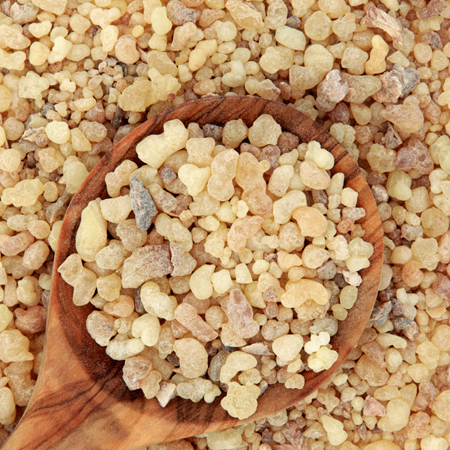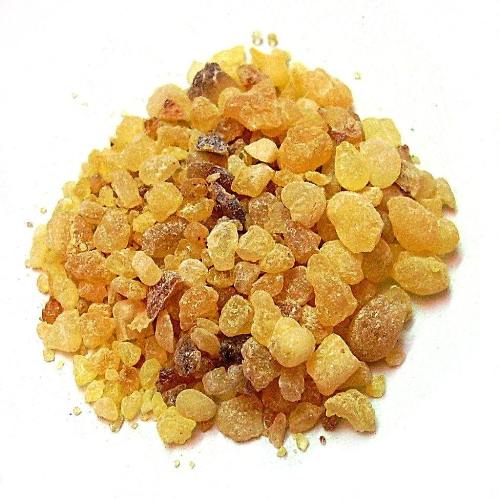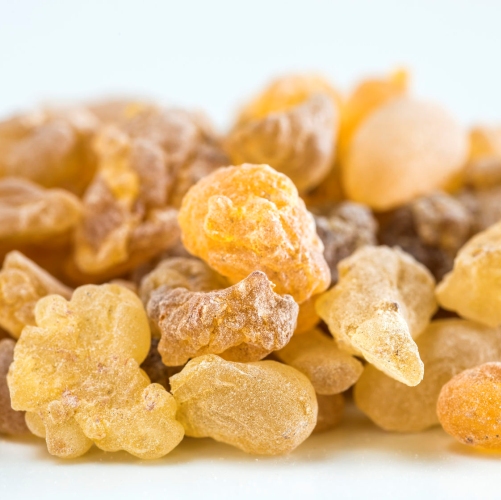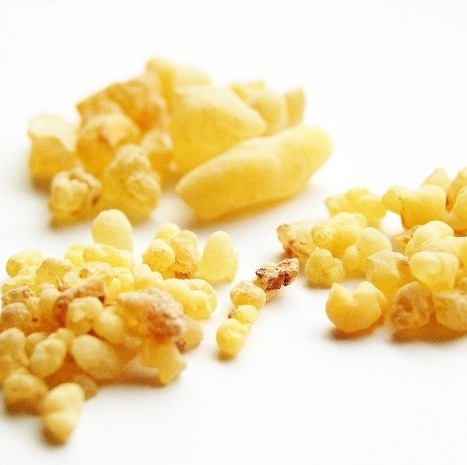





Botanical name Boswellia serrata
Family Burseraceae
Source Resin
Origin India
Processing Method Steam Distillation
Color/Consistency Colorless to pale yellow liquid.
Aromatic Summary / Note / Strength of Aroma A base note with a medium aroma, Frankincense Essential Oil has a warm and spicy, woody odor that is haunting.
Blends With Basil, Bergamot, Cardmom, Cedarwood, Chamomile, Cinnamon Bark, Clary Sage, Coriander, Geranium, Ginger,Myrrh and Vanilla.
Product Abstract
Frankincense, also known as olibanum, comes from trees in the Boswellia genus. These small trees or shrubs are native to the Red Sea area and grow wild throughout north east Africa. This tree has a number of feather-like leaves with white or pale pink flowers.
This plant produces a natural oleo gum resin which is collected through a rather time consuming process of making an incision in the bark. As a result of their incision, the tree ‘bleeds’ a milky white substance that heals the tree and prevents infection. After ten days the resin has hardened and is scraped from the tree. The highest quality frankincense comes from wounding the tree three times.
History
The use of essential oils dates back thousands of years and over this time more and more is being discovered about the potency and value of these oils. The term aromatherapy was first coined by a French chemist named Gattefosse in 1928.
Harvesting/Extraction Information
The Essential oil of frankincense is produced by steam distillation of the tree resin. The oil's chemical components are 75% monoterpenes, sesquiterpenes, monoterpenoles, sesquiterpenols and ketones. It has a good balsamic sweet fragrance, while the Indian frankincense oil has a very fresh smell. Contrary to what some commercial entities claim, steam or hydro distilled frankincense oils do not contain boswellic acids (triterpenoids), although may be present in trace quantities in the solvent extracted products
Common Usage
Caution
There are no known adverse side effects. That being said, frankincense essential oil should not be used during pregnancy, since it does act as an emenagogue and astringent.
Key constituents
a-Pinene 10.3–51.3%
a-Phellandrene 0–41.8%
(þ)-Limonene 6.0–21.9%
b-Myrcene 0–20.7%
b-Pinene 0–9.1%
b-Caryophyllene 1.9–7.5%
p-Cymene 0–7.5%
Terpinen-4-ol 0–6.9%
Verbenone 0–6.5%
Sabinene 0–5.5%
Linalool 0–5.4%
a-Thujene 0–4.5%
Bornyl acetate 0–2.9%
d-3-Carene 0–2.6%
d-Cadinene 0–2.3%
Camphene 0–2.0%
a-Caryophyllene 0–1.8%
Campholenic aldehyde 0–1.5%
Octyl acetate 0–1.5%
Caryophyllene oxide 0–1.4%
a-Copaene 0–1.4%
Calamenene 0–1.3%
Thujol 0–1.2%
1,8-Cineole 0–1.0%
(E)-Cinnamyl acetate 0–1.0%
Safety summary
Hazards Skin sensitization if oxidized.
Cautions Old or oxidized oils should be avoided.
Our safety advice
B. Serrata oil may contain a small amount of estragole, but this is unlikely to present a problem, since it contains larger amounts of anticarcinogens. No maximum is given for B. frereana or B. neglecta which, in addition to small amounts of thujone, contain higher concentrations of pinenes.
Organ-specific effects
Adverse skin reactions A 65-year-old aromatherapist with multiple essential oil sensitivities reacted to 5%, and weakly to 1% frankincense oil. B. frereana, B. sacra and B. rivae are rich in a-pinene, (þ)-limonene and/or d-3- carene. Autoxidation products of these compounds can cause skin sensitization.
Reproductive toxicity The low reproductive toxicity of sabinene, a-pinene, (þ)-limonene and octyl acetate suggests that frankincense oils are not hazardous in pregnancy.
Systemic effects
Comments
For many years there has been little clarity about the various types of frankincense and their essential oils. The current consensus is that B. carteri and B. sacra are the same plant, though this is still disputed by some. B. thurifera has sometimes been given as a synonym for these. B. bhau-dajiana is a synonym for B. sacra, but has often been given as a separate taxon in the past. Amid the confusion over nomenclature, some frankincense oils may have been ascribed to incorrect origins. A complicating factor has been that some reports were based on materials obtained from markets rather than from properly identified trees. Some of the compositional data used here for B. papyrifera were originally ascribed to B. carteri, but there now seems little doubt that frankincense oils rich in octyl acetate originate from B. papyrifera (Hall 2000). High a-pinene levels (50–80%) probably indicates B. frereana, and lower concentrations (10–50%) probably point to B. sacra, but more work needs to be done to confirm these findings. There may also be an a-thujene CT for B. sacra. There is a (þ)-limonene/(E)-bocimene CT of B. sacra (Al-Harrasi & Al-Saidi 2008) though this is probably not used for commercial es ential oil production. Some sources give a-pinene as the major constituent of B. rivae.